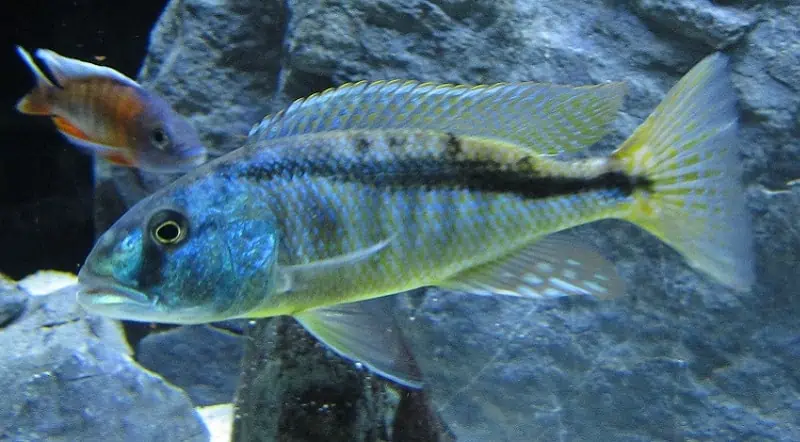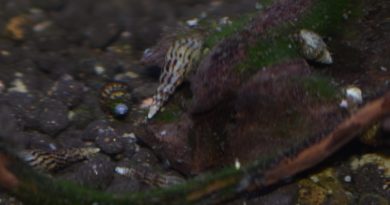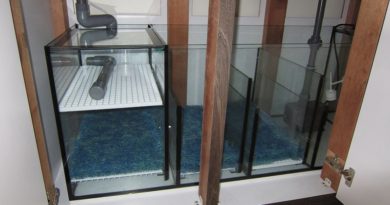Can you mix Haps and Peacock Cichlids
Can you mix Haps and Peacock cichlids in the same tank? This is a question that is frequently asked by African cichlid keepers. While there are plenty of African cichlid species which should not be kept together, from my experience, this combination usually works out great.
Haps and Peacock cichlids can be mixed successfully in most scenarios as both types of fish have similar dietary needs and tank setup requirements. The best thing about such a combination is that it can give your tank a variety of color, patterns and body shape which would be missing if keeping only one of these cichlid types.
However, there are some things to take into consideration when keeping both species in the same tank and trying to mixing peacock cichlids with predator haps is a totally different ball game, which we’ll discuss later in the article.
To begin let’s look at some of the reasons why it is a good idea to keep peacocks and haps together.
In a peacock only tank, although the color of the fish has great intensity and variety, the shape and size of the fish are much the same.
Haps on the other hand tend to have great variation in shapes, sizes and patterns but can be lacking somewhat when compared with the vivid array of colors displayed by the peacocks. A large number of haps have a dominant blue body color with only some splash of different color in the fins.
Additionally, the behavior of haps can be very different to that of peacocks. Some haps are very active swimmers preferring the open areas of the tank, while others are sand sifters and will comb the substrate for food particles.
Combining both species in the same tank can give excellent results and make for an interesting display.
Things to take into consideration when mixing haps and peacocks.
In general, I have found peacocks to be more aggressive than haps, and they are inclined to fight each other more than haps do. They usually don’t pay as much attention to the haps due to the physical differences in appearance between the species.
Haps tend to be larger fish that require more swimming space. You will need to keep this in mind and ensure that the haps you select are suitable for your tank size.
Juvenile peacocks start to show color at a much smaller size than haps. You will need to be patient waiting for the juvenile haps to get their colors. Haps usually start showing some colors at about 4 inches, for peacocks, it’s 2 to 3 inches.
There are some more fragile species of haps such as lethrinops and copadichromis that don’t do well sharing a tank with more aggressive fish, whether it be haps or peacocks. They get stressed easily and don’t display the color you would expect. It is better to keep these fish in a species only tank to allow the males to color up to their full potential when trying to attract the females.
Getting the right color mix of haps and peacocks in your tank
Red is the color I found to be lacking most in a hap only tank. Other than the Red Empress and Borleyi most haps only show red in the fins and a patch of red behind the gill plate. Below are some of the red peacock cichlids that can work well in a hap tank.
(Please note that I have no affiliation with any of the sites below. I have linked out to them as they provide a good image of the particular fish).
- Aulonocara Stuartgranti Chipoka (Ruby Red)
- Aulonocara Lwanda (Red Top Lwanda)
- Aulonocara Jacobfreibergi (Eureka Red)
- Aulonocara Stuartgranti Ngara (Ngara Flametail)
Yellow is another color that can be somewhat lacking. Although many haps do have some yellow, it doesn’t compare with the intense yellow of the peacocks. The below peacocks are a great fish to add to introduce a strong yellow color to your tank.
- Aulonocara Baenschi (Benga Sunshine)
- Aulonocara Stuartgranti Chiwindi (Blue Neon)
- Aulonocara Stuartgranti Usisya (Flavescent Peacock)
- Aulonocara Mamelela (Lemon Jake)
Don’t underestimate the wow factor of a nice OB or Dragon Blood male in your display tank. Often these will be the fish people pick as being the most striking fish in the tank.
Here are some common haps which have worked well with peacocks for me in the past.
- Sciaenochromis Fryeri (Electric Blue Hap)
- Cyrtocara Moorii (Blue dolphin)
- Protomelas Steveni Taiwan (Taiwan Reef)
- Protomelas Taeniolatus (Red Empress)
- Otopharynx Lithobates Zimbawe Rock (Z Rock)
- Otopharynx Tetrastigma (Tetrastigma)
Can I keep peacock cichlids with Predator Haps?
Keeping peacocks with predator haps is more difficult to manage than with regular haps. Predator haps are much larger fish, ranging in size from 12 to 16 inches. While most will show little interest in making a snack of an adult peacock there are some exceptions.
When mixing peacocks with predator haps it is important to ensure that the peacocks are already quite large when they are added to the tank, or to buy juvenile haps which are smaller than the peacocks and allow them to grow up together. Predator haps grow fast so ensure that the peacocks have a size advantage to start off with. It may seem that the peacocks are able to bully them initially but that will change over the coming weeks as they start to put on some size.
Certain predator haps such as the Tyrannachromis Maculiceps have a huge mouth that could easily swallow a mid-size peacock. Others like the Aristochromis Chrystii (Malawi hawk) and Dimidichromis Comprissiseps (Malawi eye biter) seem to retain their predatory instinct. Although unlikely that they will be able to eat a large peacock, the danger is always there and their hunting behavior is interesting to watch.
Here are some predator haps which I have kept with peacocks in the past.
- Buccochromis Nototaenia
- Champsochromis Caeruleus
- Fossorochromis Rostratus
- Nimbochromis Venustus
- Nimbochromis Fuscotaeniatus
Summary
Keeping haps and peacock cichlids together makes for an interesting and colorful tank. They are very compatible in regards to diet and tank requirements.
Some haps get large, make sure to do your research before purchasing to ensure you have an appropriately sized tank.
Thanks for reading. If you found this article helpful, don’t forget to share 🙂



